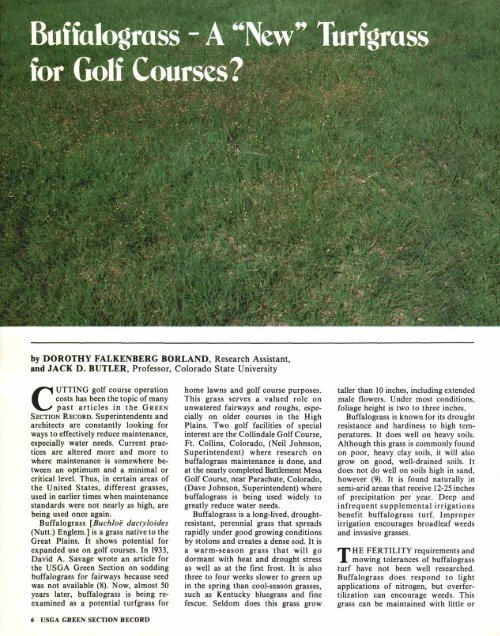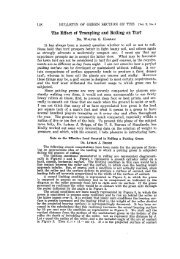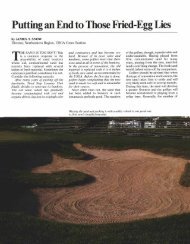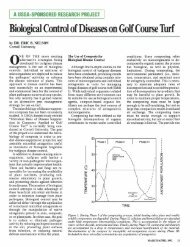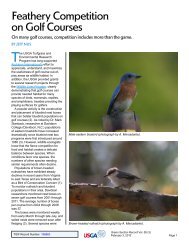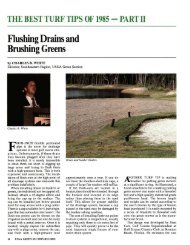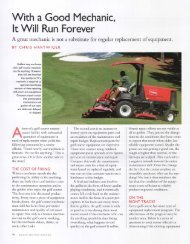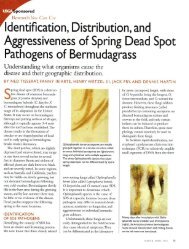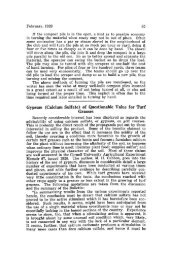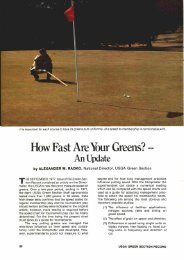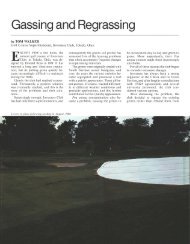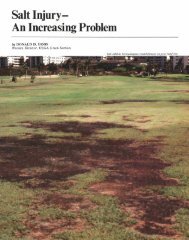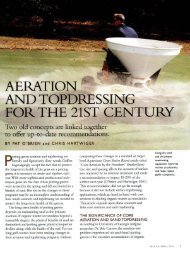Buffalograss - USGA Green Section Record
Buffalograss - USGA Green Section Record
Buffalograss - USGA Green Section Record
- No tags were found...
You also want an ePaper? Increase the reach of your titles
YUMPU automatically turns print PDFs into web optimized ePapers that Google loves.
y DOROTHY FALKENBERG BORLAND, Research Assistant,and JACK D. BUTLER, Professor, Colorado State UniversityCUTTING golf course operationcosts has been the topic of manypast articles in the GREENSECTIONRECORD. Superintendents andarchitects are constantly looking forways to effectively reduce maintenance,especially water needs. Current practicesare altered more and more towhere maintenance is somewhere betweenan optimum and a minimal orcritical level. Thus, in certain areas ofthe United States, different grasses,used in earlier times when maintenancestandards were not nearly as high, arebeing used once again.<strong>Buffalograss</strong> [Buchloe dactyloides(Nutt.) Englem.] is a grass native to theGreat Plains. It shows potential forexpanded use on golf courses. In 1933,David A. Savage wrote an article forthe <strong>USGA</strong> <strong>Green</strong> <strong>Section</strong> on soddingbuffalograss for fairways because seedwas not available (8). Now, almost 50years later, buffalograss is being reexaminedas a potential turfgrass for6 VSGA GREEN SECTION RECORDhome lawns and golf course purposes.This grass serves a valued role onunwatered fairways and roughs, especiallyon older courses in the HighPlains. Two golf facilities of specialinterest are the Collindale Golf Course,Ft. Collins, Colorado, (Neil Johnson,Superintendent) where research onbuffalograss maintenance is done, andat the nearly completed Battlement MesaGolf Course, near Parachute, Colorado,(Dave Johnson, Superintendent) wherebuffalograss is being used widely togreatly reduce water needs.<strong>Buffalograss</strong> is a long-lived, droughtresistant,perennial grass that spreadsrapidly under good growing conditionsby stolons and creates a dense sod. It isa warm-season grass that will godormant with heat and drought stressas well as at the first frost. It is alsothree to four weeks slower to green upin the spring than cool-season grasses,such as Kentucky bluegrass and finefescue. Seldom does this grass growtaller than 10 inches, including extendedmale flowers. Under most conditions,foliage height is two to three inches.<strong>Buffalograss</strong> is known for its droughtresistance and hardiness to high temperatures.It does well on heavy soils.Although this grass is commonly foundon poor, heavy clay soils, it will alsogrow on good, well-drained soils. Itdoes not do well on soils high in sand,however (9). It is found naturally insemi-arid areas that receive 12-25 inchesof precipitation per year. Deep andinfrequent su pplemental irrigationsbenefit buffalograss turf. Improperirrigation encourages broadleaf weedsand invasive grasses.THE FERTILITY requirements andmowing tolerances of buffalo grassturf have not been well researched.<strong>Buffalograss</strong> does respond to lightapplications of nitrogen, but overfertilizationcan encourage weeds. Thisgrass can be maintained with little or
no mowing; however, mowing can beused regularly throughout the seasonto give a more manicured appearance.A mowing height of between 1.5 and 2inches can remove the male flowers andclean up the turf (I).Tolerance to traffic is of concern ongolf courses, and observations indicatethat buffalograss will tolerate carttraffic quite well. As a range grass,buffalo grass can tolerate a high degreeof trampling and the associated closeclipping of grazing (often to 0.5 inches)(9). Fraser and Anderson (2) found thatTexoka buffalograss tolerated amoderate level of continual traffic anda regular mowing program very well.Nevertheless, if buffalograss is severelyworn, regrowth may be slow or nonexistant,because regrowth occurs onlyfrom stolons.<strong>Buffalograss</strong> is rarely troubled byinsects or disease if not over-irrigatedor over-fertilized. However, it can serveas a host for many types of insects andcommon turf diseases.Once established, it can produce atough sod that has few weed problems.Weeds can be a problem, however,until almost complete cover is achieved.Several chemicals have been tested onbuffalograss, but potential turf injuryand lack of labeling is of concern. 2,4- D[(2,4-dichlorophenoxy) acetic acid] isoften used for weed control in buffalograss,but it may cause leaf burn andstunting of seedlings and mature plants,especially if plants are stressed at timeof application (4, 7, 9). Pre-emergentherbicides such a propazine, siduron,and simazine seem to have little, if any,damaging effects when applied at seeding,when applications are at label rates(5, 6). Successful weed control with nodamage to dormant buffalograss turfhas been reported using high rates ofTrimec@, Roundup@, and WeedoneSuper D@ (6).With the recent surge of interest indry-land landscapes, more detailedknowledge was needed about buffalograss.Since most of the work donepreviously was concerned with dry-landrange needs, research to test variousuntried establishment and maintenancepractices on buffalo grass for turf purposeswas instigated at Colorado StateUniversity. Practices studied includedseeding date and rate and effect of preplantand maintenance fertilization. Acomprehensive thesis on buffalograssand other dry-land grasses is available(1), and it would be useful for thoseconsidering planting buffalograss turf.TWO AREAS OF importance inestablishment of turf, either for ahome lawn or a golf course, are optimumseeding date and seeding rate. Onlyrarely are turf professionals able to seedat the optimum time; however, seedingat the best time can provide greatreturn. <strong>Buffalograss</strong> can, in most of itsareas of adaptation, be seeded anytimefrom mid-May until the end of August.In these studies best germination andsubsequent cover was achieved byseeding in May. Early fall (Septemberor later) is not advisable unlessUNTREATED seed is used and germinationis expressly planned for thefollowing spring. By the second year,there was no appreciable differencebetween test plots seeded in May andJuly.Seed cost is another important consideration.<strong>Buffalograss</strong> seed is expensive(wholesale cost in 1982 is $8.00 perpound) due to the difficulty in harvestingthe burs that are found close to theground. Also, the pretreatment that isnecessary to ensure a high percentageof germination adds to the cost. Theburs contain two to five seeds, with anaverage of two seeds per bur. A poundcontains about 50,000 burs.Recommended seeding rates for buffalograssfor turf are high, as much as7 Ibs.jl,OOO ft.2 (7). When comparingfive different broadcast seeding rates,adequate cover was achieved in one dryseason with no supplemental water(beyond germination and initial establishment)using 3.91bs.jl,000 ft. 2 • Withno irrigation beyond initial establishment,2.3 Ibs. / 1,000 ft. 2 producedadequate cover within two growingseasons. Lower rates might be used andadequate cover achieved in one seasonif a regular irrigation schedule isplanned or summer rains occur fairlyregularly. After establishment, thefrequency of irrigation can be adjustedfor weather conditions and quality andrate of cover desired.Color, density, and quality ratingscomparing various seeding rates to aAt Ft. Collins, Colorado, un watered buffalograss roughs:After heavy spring rains in May. In June. In August.
good-quality buffalo grass turf weremade during the seeding year and thesecond season. During the seeding year,color was better in the plots withsparser stands than with those seededat higher rates. Color differences werenot visible during the second season,when color was acceptable throughout.Heavier seeding rates (2.3, 3.9, and 5.5Ibs.j 1,000 f1. 2 ) produced better cover,and the lowest seeding rates (0.4 and 0.8Ibs.j 1,000 f1. 2 ) produced unacceptablecover. The trend was similar during thesecond season. Quality was based onboth color and density.THE USE OF preplant fertilizers forestablishment of high-quality turfis a common practice. Preplant fertilizerbenefits on buffalograss were examined.There were no significant differences ingrowth rate or appearance with fertilizationdespite low soil nutrient levels atplanting.As a range grass, fertilization is oftenconsidered unnecessary for establishedbuffalograss. However, a study atCollindale Golf Course showed thatestablished buffalo grass without irrigation,except to water fertilizer in,responds favorably to nitrogen fertilization.Nitrogen at a rate of 0.5 lb. N j1,000 f1.2 applied monthly during thegrowing season increased turf quality,color, and density greatly. Applicationsonly in July or at a heavier rate (2 Ibs. j1,000 ft. 2 ) as a dormant, because ofdrought, treatment in August alsoimproved overall turf quality. Aresidual effect from fertilizer applicationwas noted the second spring.In the U.S.A., there is a "new" grassfor golf course use. <strong>Buffalograss</strong> canprovide a suitable turf for golf purposeseven when it is dormant and dry.Although buffalograss is native to theGreat Plains, undoubtedly it will performsatisfactorily in several otherareas. It withstands many of the climaticextremes common in the semi-arid HighPlains, and it responds well to propermowing, watering and fertilization.More research needs to be done toestablish its environmental toleranceand to determine its disease and insectsusceptibility, as well as to find itsoptimum irrigation. But here is a grasswith potentials yet untapped. No dou bt,as our resources become more and morelimited, the use of this grass will begreatly extended.LiteratureCited1. Falkenberg, D. A. 1982. "<strong>Buffalograss</strong>,Blue Grama, and Fairway Wheatgrassfor Dryland Turf." M.S. Thesis, Colo.St. Univ., Fort Collins, CO. 189 pp.2. Fraser, J. G., and J. E. Anderson. 1980."Wear Tolerance and Regrowth BetweenCuttings of Some Native Grasses UnderTwo Moisture Levels." New MexicoAgr. Exp. Sta. Res. Rept. 418. 5 pp.3. Hitchcock, A. S. 1971. "Manual of theGrasses of the United States." SecondEdition. 2 volumes. Dover Publications,New York. 1051 pp.4. Keen, R. 1969. "Turfgrasses UnderSemi-Arid and Arid Conditions." pp.529-541. In A. A. Hanson and F. V.Juska (eds.) Turfgrass Science, Amer.Soc. Agron. Monograph No. 14.715 pp.5. McCall, D. A. 1973. "The Effect ofThree Pre-Emergence Herbicides onGermination and Growth of 24 Erosion-Resistant Plant Materials for PossibleUse on Roadside Erosion Control."M.S. Thesis, Okla. St. Univ., Stillwater,OK.6. Pair, J. 1980. "Turfgrass Research FieldDay Report." Wichita HorticultureResearch Center, Kansas St. Univ.,Manhattan, KS. 10 pp.7. Powell, G. 1980. Personal letter. CarlWorthington Partnership, 1309 Spruce,Boulder, CO 80302.8. Savage, D. A. 1933. "Buffalo Grass forFairways in the Plains States." <strong>USGA</strong><strong>Green</strong> <strong>Section</strong> Bull. 13(5):144-149.9. Wenger, L. E. 1943. "Buffalo Grass."Kansas Agr. Exp. Sta. Bull. 321. 78 pp.10. Wheeler, W. A. 1950. "Forage andPasture Crops." D. Van Nostrand Co.,Inc., New York. 725 pp.Established buffalograss can withstand heavy traffic, even when dormant. The green grassis Kentucky bluegrass.


